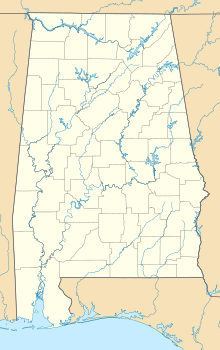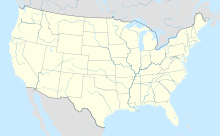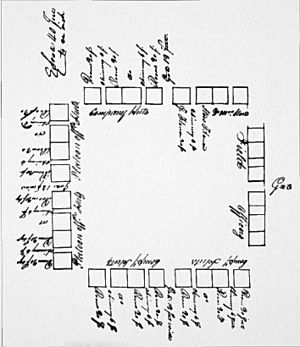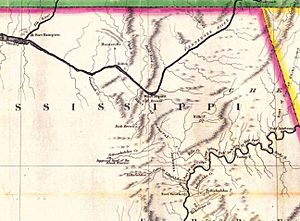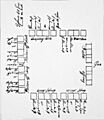Fort Hampton (Alabama) facts for kids
Quick facts for kids Fort Hampton |
|
|---|---|
| Athens, Alabama in United States | |
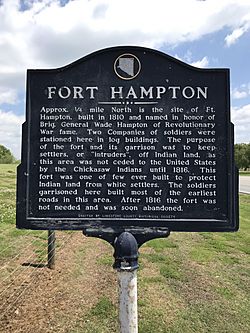
Historical marker for Fort Hampton
|
|
| Coordinates | 34°48′23″N 87°11′55″W / 34.80639°N 87.19861°W |
| Type | Log buildings |
| Site information | |
| Owner | Private |
| Controlled by | Private |
| Open to the public |
No |
| Condition | Site occupied by private home |
| Site history | |
| Built | 1810 |
| Built by | United States Army |
| In use | 1810–1817 |
| Battles/wars | War of 1812 |
Fort Hampton was a group of log buildings and stables. It was built in 1810 in what is now Limestone County, Alabama. The fort was located on a hill close to the Elk River. It was named after Brigadier General Wade Hampton. The fort's main purpose was to stop American settlers from moving onto land that belonged to the Chickasaw people. Later, it was used during the War of 1812 and for other government tasks before it was left empty.
Contents
Fort Hampton: A Frontier Story
Why Fort Hampton Was Built
Before Europeans arrived, the area that is now Alabama was home to many Native American groups. These included the Creek, Cherokee, Choctaw, and Chickasaw. As more European settlers came, the Native American groups changed their lands and friendships.
The Chickasaw people gained control of the Tennessee Valley in northwest Alabama. This happened after they defeated the Shawnee in the early 1700s. In 1806, the Cherokee sold their claim to land in Limestone County. However, the Chickasaw kept their rights to the land. This created a border between Chickasaw land and land that settlers could buy.
Early American settlers came to North Alabama by flatboats on the Tennessee River. Others came from states like Georgia, South Carolina, and Virginia. They often followed old Native American trading paths. Many settlers liked the area because of its rivers and good soil for growing cotton.
Some settlers did not respect the border lines. They moved onto land that belonged to the Chickasaw. The Chickasaw asked the United States government to stop these illegal settlements. In response, the U.S. government told the settlers to leave.
In 1809, Colonel Return J. Meigs Sr. and his soldiers marched from Kingston, Tennessee. They forced settlers to move out of Chickasaw territory. But many settlers did not leave, or they soon came back. Colonel Meigs suggested that a permanent military base was needed to keep settlers away. This led to the United States Army building Fort Hampton in the fall of 1810.
Building the Fort
In 1810, Brigadier General Wade Hampton gave an order. Major John Fuller and 104 soldiers were to march to the Elk River area. They came from Cantonment Washington. After a 48-day march in the summer, the soldiers arrived. They had no tools, tents, or other supplies because their supply boat was delayed.
Fort Hampton was built on a hill southeast of the Elk River. This is in what is now Limestone County, Alabama. This spot was chosen because it was near the illegal settlements. It was also close to Melton's Bluff, where the fort was first planned.
At first, the fort was just a group of log cabins, a brickyard, and stables. It did not have strong defenses or a place to store weapons. This was because it was meant to be a place for talking and agreements, not fighting. Later, a central courtyard was built with 32 log cabins around it. In 1812, the fort was made stronger. It was enclosed, blocked off, and cannons were placed outside.
Fort Hampton's Military Role
After it was built, Fort Hampton was a base for soldiers. They mostly built roads, but they also patrolled. They protected Chickasaw property. The main job of the soldiers was to keep settlers off Chickasaw lands. As part of this, they burned the cabins of many early settlers in Limestone County.
The fort was first guarded by soldiers from the Regiment of Riflemen. Major John Fuller was in charge. But he was soon arrested. Colonel Robert Purdy then took command. Other important people at the fort included Colonel John Williams.
Sam Houston was stationed at Fort Hampton after joining the army in 1813. His brother, Robert, was the commanding officer of the 8th Infantry there. This was from 1816 until the fort was left empty in 1817.
In October 1813, Andrew Jackson warned of a possible attack. He thought the Creek people might attack Fort Hampton and Huntsville. Jackson ordered General John Coffee to send more soldiers to Huntsville and Fort Hampton. The attack never happened. General Coffee then went to scout for hostile Creeks and burn their villages.
When Jackson started attacks on Pensacola and New Orleans, soldiers and supplies were sent from Fort Hampton. They went to help Jackson's forces. After these forces left, local soldiers, led by Captain John Allen, stayed at Fort Hampton for almost a year. Captain Allen also worked as a subagent for the Chickasaw. His men did their duty without pay at first, but they were paid later.
In the winter of 1814, a group of volunteer soldiers from West Tennessee stopped at Fort Hampton. They were on their way to New Orleans. In August 1816, the 8th Infantry Regiment of the United States was stationed at Fort Hampton. They were under the command of Robert Butler.
After the War
After the Chickasaw sold the land around Fort Hampton to the United States, soldiers were no longer needed. The military post at the fort was closed. The troops were sent to help build a military road.
Some of Fort Hampton's buildings were still standing in 1821. But most were thought to have been moved. Fort Hampton was then used as a court location. It served for Elk County, Mississippi Territory, and later Limestone County, Alabama Territory.
A community with the same name grew around Fort Hampton. A post office operated there from 1861 to 1872. Local groups also had meeting places in Fort Hampton.
Fort Hampton Today
The original site of Fort Hampton is now a private home. A historical marker was placed by the Limestone County Historical Society in the 1970s. It is on the side of U.S. Route 72.
A team from the University of West Florida dug at the site in 2013. They confirmed the fort's location. They also found some old items related to the fort's military use.
Images for kids


